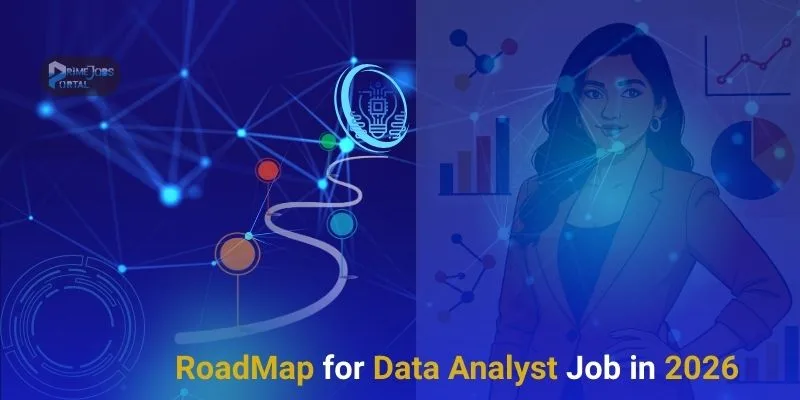Ready to jump into the world of data? For good reason, becoming a data analyst is a popular career choice Businesses are collecting more data than ever before and need skilled people to make sense of it all.
As we head into 2026, the demand for data professionals is only going to grow, with over 11.5 million new data-related jobs expected to be created worldwide. This article will be your roadmap to becoming a successful data analyst, even if you’re a complete beginner.
What is a Data Analyst?
- Imagine a company wants to know why a product isn’t selling well. They have tons of information customer reviews, sales numbers, website clicks, and more.
- A data analyst is like a detective who sifts through all this raw, messy data to find the clues.
- They use special tools to clean up the data, look for patterns and trends, and then present their findings in a clear, easy-to-understand way, often using charts and graphs.
- The goal is to help the company make smarter decisions, not based on guesswork, but on solid evidence.
Why is this job so popular?
- The demand for data analysts is booming. In places like India, it’s growing at an incredible rate of 25–30% year-on-year.
- Since skilled professionals are fewer in number but demand is very high, there are many job openings with good salary packages.
- For a fresher in India, the average annual salary can range from ₹4 to ₹10 lakhs, with experienced professionals earning much more.
- This is a career with serious growth potential, not just in salary, but in advancing to roles like Data Scientist or Analytics Manager.
Common Hurdles for Aspiring Analysts
Before we get to the solutions, let’s talk about the challenges you might face. These are the pain points that stop many people from even starting.
- I don’t have a technical background. A common myth is majority belief for becoming a data analyst requires a degree in statistics or computer science.
- While a quantitative background helps, it’s not a big issue. The reality is, many of the most in-demand skills can be learned through online courses and self-study.
- The amount of information is overwhelming. A quick Google search for “how to become a data analyst” gives you a thousand different paths, tools, and languages.
- It’s easy to get lost in the noise and not know where to start.
- I don’t have real-world experience.
- You don’t always need a computer science or statistics degree to start a career as a data analyst. This seems awkward frustrating and can make you feel stuck.
- How do I stand out from the crowd, With so many people trying to break into data.
- How do you make your resume shine Just having a certification isn’t enough anymore; you need to prove you can do the work.
What Keeps You Engaged and Motivated
Overcoming these pain points requires the right mindset and a clear strategy. Here are the Hooks that will keep you on the right path.
- The Power of a Why Don’t just learn skills, find problems you care about.
- Do you love sports? Analyze player performance.
- Are you interested in healthcare? Study patient data to find trends.
- When you work on projects that genuinely interest you, the learning process becomes a fun challenge and doesn’t look like a task.
Learning in Public
- Instead of studying alone, join online communities on platforms like Reddit, Discord, or GitHub.
- This not only builds your network but also holds you accountable and shows potential employers your passion and collaborative spirit.
The Storyteller’s Superpower
- A great data analyst isn’t just good with numbers; they’re great storytellers.
- The most valuable skill is the ability to take a complex spreadsheet and turn it into a clear, compelling narrative that anyone, from a CEO to a marketing intern, can understand.
- Focusing on this skill will make you an indispensable asset.
The Solutions: Your Step-by-Step Guide for 2026
Forget the overwhelming jargon. Here is a simple, actionable plan to get you hired as a data analyst in 2026.

Step 1: Master the Foundational Skills
- Think of these as your essential tools. You don’t need to be an expert in everything, but you must be proficient in these core areas.
- The Starting point is spreadsheets (Excel or Google Sheets), You’ll use it for quick data cleaning, sorting, and basic calculations.
- A solid grasp of functions like VLOOKUP, INDEX/MATCH, and Pivot Tables is a must.
- The most important skill for a data analyst is definetly SQL (Structured Query Language).
- The language you use to communicate with databases is called SQL.
- You’ll use it to pull the exact data you need, clean it, and join it with other datasets.
- Focus on commands like SELECT, FROM, WHERE, GROUP BY, and JOIN.
Data Visualization Tools (Tableau or Power BI)
- Once you have your clean data, you need to show your findings.
- These tools turn numbers into beautiful, interactive charts and dashboards.
- They are the public-facing part of your work and a key way to impress recruiters
Programming Language (Python or R)
- While Excel and SQL are your bread and butter, a programming language takes you to the next level.
- Python is a popular choice due to its versatility and powerful libraries like Pandas (for data manipulation) and Matplotlib/Seaborn (for plotting).
- R is a good platform for anyone with a strong statistical background.
- You don’t need to be a coding genius, but you should know how to use these tools for more complex analysis and automation.
Step 2: Build a Portfolio of Projects
- Your portfolio is your proof of work. It shows recruiters that you can apply your skills to real problems.
- Find Interesting Datasets: Websites like Kaggle, Google Dataset Search, and data.gov have thousands of free datasets on every topic imaginable.
- Start with a Simple Project: Don’t try to build something huge. Pick a small, manageable problem. For example, “What factors influence customer ratings for a product?”
- Follow the Data Analysis Process: For each project, document your entire process:
- Describe the issue: What query/ticket are you attempting to address
- Collect and Clean Data: Where did you get the data, and how did you prepare it for analysis? This is often the most time-consuming step, and showing you can do it well is a huge plus.
- Analyze and Explore: What patterns or insights did you find? Use your skills in SQL and Python/R here.
- Visualize and Present: Create a dashboard or a simple report with your findings. Try to explain what the data means in simple common man terminology.
- Make it Public: Put your projects on a platform like GitHub. Write a clear, concise README file for each project, explaining your process and findings.
Step 3: Upskill and Stay Current
- The world of data is always changing. To stay competitive in 2026, you’ll need to look beyond the basics.
- Learn a little Machine Learning: You don’t need to be a Machine Learning Engineer, but having a basic understanding of concepts like supervised vs unsupervised learning and simple models like linear regression will set you apart.
- Explore Big Data Tools: As datasets get larger, you might encounter tools like Apache Spark or cloud platforms like AWS, Azure, or Google Cloud. Knowing the basics of how these work shows you’re ready for bigger challenges.
- Develop Your Soft Skills: This is often overlooked but incredibly important. Practice communicating complex findings in simple terms. Work on your problem-solving and critical thinking.
Step 4: Network and Get Hired
- This is the final stretch. A great resume and portfolio are useless if nobody sees them.
- Optimize Your LinkedIn Profile: Make sure your profile clearly states that you are an aspiring data analyst. List your skills and link to your portfolio projects.
- Tailor Your Resume: Don’t use a generic resume. For every job application, highlight the skills and projects that are most relevant to that specific role.
- Prepare for Interviews: Practice explaining your projects in detail. Be ready for both technical questions (e.g., “Write a SQL query to find X”) and behavioral questions (e.g., “Tell me about a time you solved a difficult problem”).
- Look for Internships or Entry-Level Roles: Don’t be discouraged by job titles that sound too advanced. Many “Junior Data Analyst” or “Business Intelligence Analyst” roles are perfect for entry-level candidates. Look for companies that offer apprenticeship or rotational programs
The Future is Data-Driven
- The future is bright for data analysts. By 2026, data will be even more central to every business, and skilled analysts will be the navigators, guiding companies through a sea of information.
- By following this roadmap mastering the core skills, building a portfolio, staying curious, and networking you’re not just preparing for a job; you’re building a career that is both rewarding and in high demand. Now, go out there and start your data journey
Read More …….








